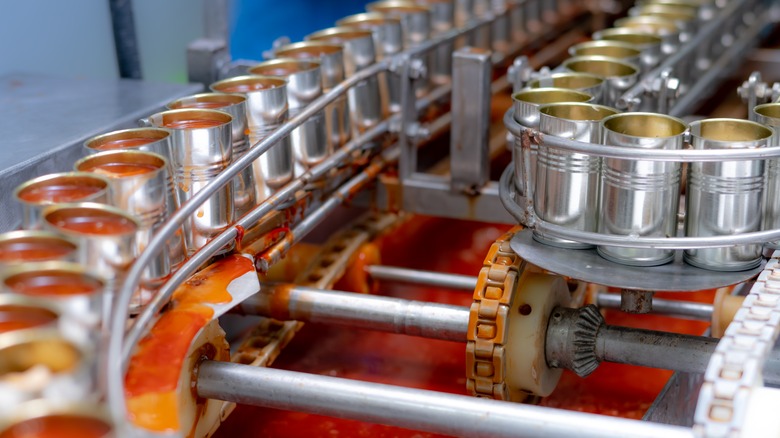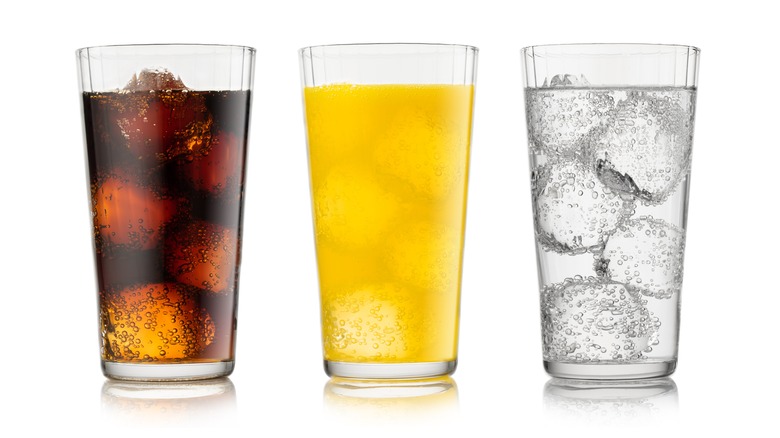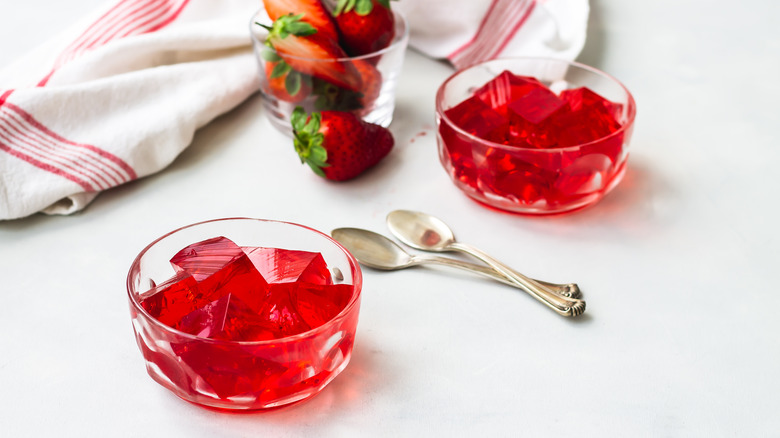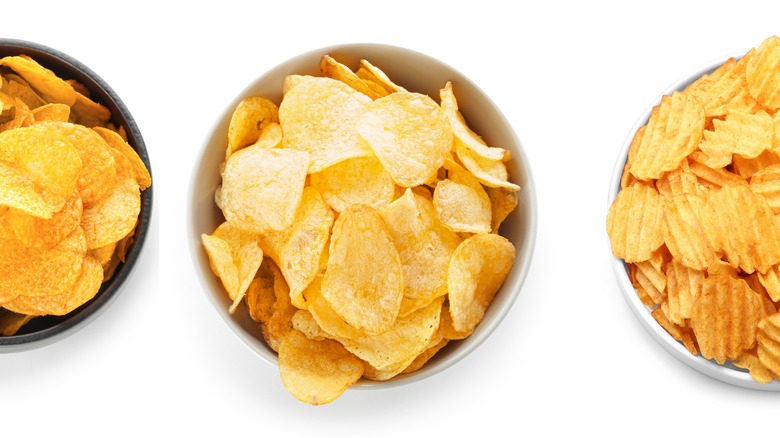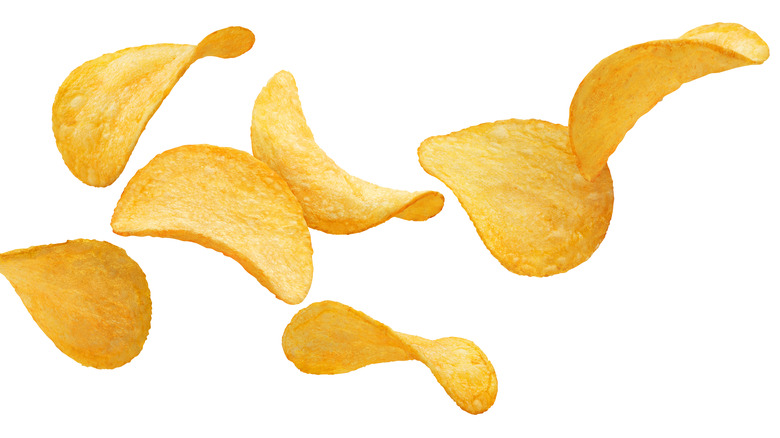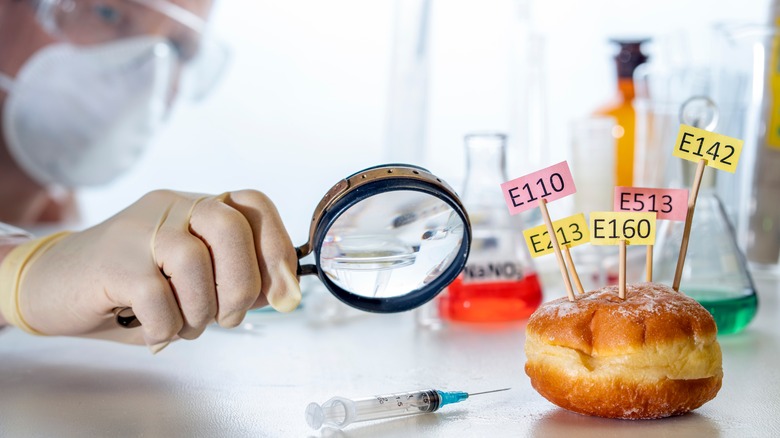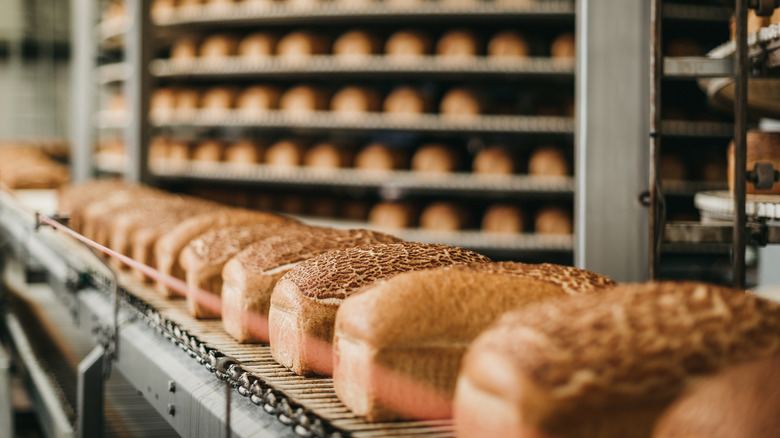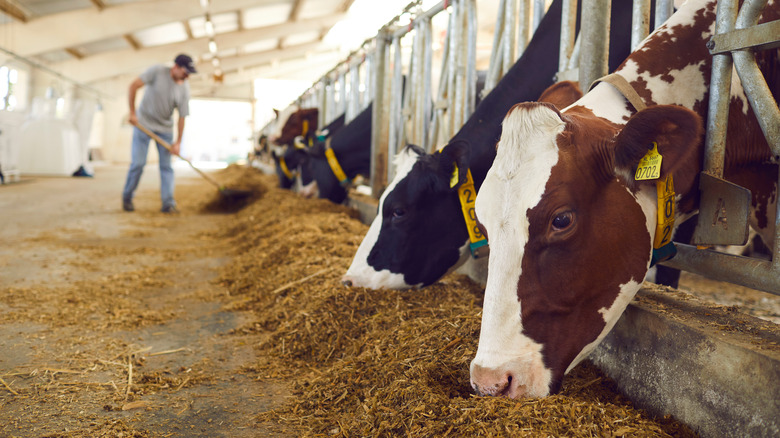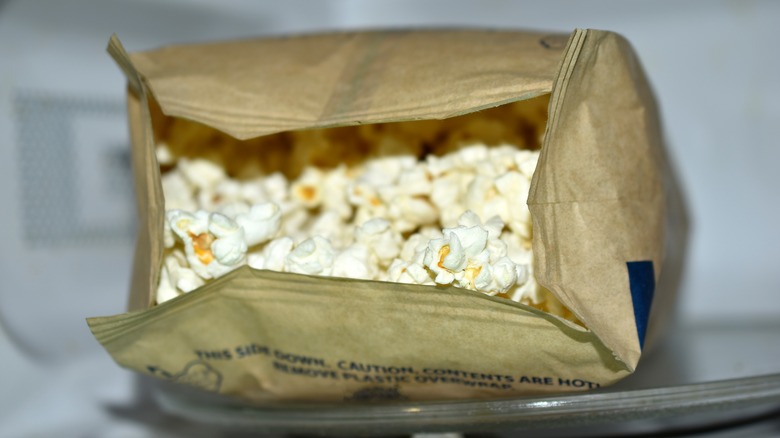13 Questionable Food Additives In US Foods, Explained
There's something less than appetizing about eating an ingredient that you can't pronounce. Words like "butylated hydroxytoluene" and "tert-butylhydroquinone" don't exactly conjure up images of a home-cooked meal at grandma's house. Additives like these are used for many reasons: to preserve food for longer, to make it appear more appetizing, and to add flavor. While not all food additives are necessarily bad, there are many food additives used in the United States that are actually banned in other countries.
While the European Union and many other nations take a precautionary stance on food additives, banning those that have the potential to cause adverse effects in humans, the U.S. take a more lenient stance, focusing on the probability of things going wrong instead of the possibility, according to Everyday Health. The American food industry also has a large, well-funded lobby presence, which ensures that food manufacturers here can influence government regulations to continue to produce goods at a minimal cost.
The Food and Drug Administration is the government body charged with regulating food additives in the United States. Since 1958, in order to introduce additives into products meant for human consumption, companies must file a petition with the FDA that presents evidence that the substance is safe, according to the U.S. Department of Agriculture. Although legal food additives are considered generally safe for consumption by the FDA, we've compiled a list below of commonly used food additives that are still considered questionable by many.
Titanium dioxide
Celebrations often call for food coloring. It's tempting to dye your friend's birthday cake their favorite color or cover some tasty sweet treat with edible glitter to give dessert a bold visual bang. But party people be aware, because titanium dioxide, a common food additive, is now banned in the EU. This odorless powder is commonly added to products to give them a pearly, opalescent look. Foods that often contain titanium dioxide include gum, candies, chocolate, pastries, and coffee creamer. It's also used to enhance the colors of over-the-counter and cosmetic products like sunscreen, lipstick, toothpaste, and creams.
According to the European Food Safety Authority, titanium dioxide can accumulate in the body, resulting in potential neurotoxicity, inflammation, and even damage to DNA, which can lead to the formation of cancer cells. For this reason, the EFSA no longer considers titanium dioxide safe when used as a food additive. The FDA still considers titanium dioxide safe for human consumption, but the International Agency for Research on Cancer lists it as possibly carcinogenic to humans.
Potassium bromate
It's no secret that bread is a complicated science. Getting bread to have that perfect rise, crunchy crust, and fluffy body isn't easy and it takes time. Gluten, which forms the backbone of any bread-making endeavor, has to rest in order for the chemical bridges that bind the molecules together that lead to the properties we associate with great bread. But at some point, food scientists discovered a workaround: potassium bromate (PB).
According to Live Science, PB is a powerful oxidizing agent that bleaches bread dough and increases its elasticity without having to wait for the bread flour to age. This results in the soft, fluffy, white bread that you're probably used to seeing in the supermarket. Ideally, the chemical is baked off during the heating process, but if any is left, it has been proven to cause cancer in the thyroids, kidneys, and other body parts of rats and mice in studies. The additive is banned in Europe, China, Canada, and Brazil, and in California, state law requires warning labels to be displayed on products containing PB.
Brominated vegetable oil
There's nothing like a cold, fizzy beverage. But watch out before you pop open a can of soda, because there's an additive that you might want to avoid. Brominated vegetable oil (BVO) is an emulsifier, which helps to keep the color and cloudiness even in liquids, per NPR. While popular colas like Pepsi and Coca-Cola have recently stopped adding BVO, the additive is still present in about 10% of soft drinks sold in the United States, according to Scientific American.
Not only does "brominated vegetable oil" have a rather unpleasant ring to it, especially when it's something being added to your soda, but researchers in the 1970s found that rats fed a diet with BVO developed lesions in their heart muscles, according to the Hong Kong Centre for Food Safety. For this reason, the additive is banned in Japan, China, Australia, New Zealand, Europe, and Singapore. In the United States, BVO is allowed in small amounts. The Food and Drug Administration reasoned that the amount of BVO in the studies conducted far exceeded the amount of human consumption.
Butylated hydroxytoluene
If you're on a European vacation and you're looking to get a taste of home in the form of a box of Wheat Thins, you may be disappointed to find that they're actually banned in some other countries, including the United Kingdom and many other European nations. And it's all because of one additive used in the packaging: butylated hydroxytoluene, or BHT. The chemical, which was synthesized in a lab, is an antioxidant that helps stabilize vegetable oils so that they stay fresh longer and it's often used in crackers and cereals to extend their shelf life.
Although it's still allowed in the United States, some companies like General Mills no longer use the additive in their products because of its bad reputation, according to Chemical and Engineering News. Studies in rats and mice found that prolonged exposure to BHT led to liver, thyroid, and kidney problems and in some cases, it encouraged the growth of tumors, per the David Suzuki Foundation.
Azodicarbonamide
Although McDonald's has never been hailed as a haven of health food, it was still a surprise to hear Senator Charles Schumer claim in 2014 that customers of the ubiquitous fast-food chain are being "served toxic chemicals," per ABC News. The subject of his accusation is azodicarbonamide (ACA), an additive used in bread production that helps bleach the flour to keep bread white.
While the whitening agent is banned in the United Kingdom and the European Union, it is still widely used in the United States at several chains including Kentucky Fried Chicken, Starbucks, Arby's, and Dunkin' Donuts, per the Huffington Post. Although ACA is considered "generally safe" by the FDA, according to the Center for Science in the Public Interest, it breaks down into two chemicals that have been recognized as carcinogens. The food blogger Vani Hari, who created the blog Food Babe, even started a petition to have sandwich chain Subway stop using the ingredient in its bread, which it did in 2014, according to CBS News.
Tartrazine (yellow 5)
Tartrazine, more commonly known as yellow 5, is a widely used additive in food and cosmetics. According to WebMD, the product, which is used to dye food in order to make it look more fresh and appetizing, can be found in everything from cereals and sodas to yogurt, juices, and even lipstick and toothpaste. While yellow 5 was approved for consumption by the FDA in 1969, it is banned in Austria and Norway and in the rest of the EU, and products containing it must display a warning label that advertises the potential health effects, according to Healthline.
Between 2004 and 2007, a series of studies revealed a link between artificial food coloring and hyperactivity in children. While many companies continue to use yellow 5 in their products, some brands like Kraft Foods and Mars, Inc. have responded to public concern over the additive by replacing it with natural alternatives like paprika, beetroot extract, and carrot oil, which can also be used to dye foods.
Butylated hydroxyanisole
Preservatives can extend the shelf life of a variety of products by stabilizing fats that will otherwise go rancid, which is why they're widely used by food companies, according to Live Science. Butter, cereal, and many chip brands are just a few of the products that often contain one of the most common food preservatives, butylated hydroxyanisole, or BHA. While it may help keep products in your pantry longer, BHA has a questionable reputation.
According to the Vermont Department of Health, BHA can cause cancer in animals and may affect the way hormones function in the human body. These concerns are serious enough that it is listed as a category 1 endocrine-disrupting chemical in the EU and is listed as a cancer-causing chemical by the California Office of Environmental Health Hazard Assessment. While anybody is at risk for consuming BHA, the risk of absorption is highest with a high-fat diet.
Olestra
There are plenty of ways to lose weight. While diet and exercise are consistently the most important factors that can help you shed extra pounds, it's tempting to try a shortcut. Enter olestra. This calorie-free fat substitute was first approved for use by the FDA in 1996 and has since made its way into low-calorie snacks like Lay's and Pringles "Light" chips, according to the Calorie Control Council. Olestra provides the flavor of fat but is not absorbed by the digestive system, so it doesn't add any extra calories.
That may sound great, but according to the Center for Science in the Public Interest, Olestra can cause "diarrhea and loose stools, abdominal cramps, flatulence, and other adverse effects" that are "sometimes severe." Not only that, but the compound can prevent the body from absorbing fat-soluble nutrients in fruits and vegetables that are believed to help prevent cancer and heart disease. Instead of opting for low-calorie, greasy-tasting chips, choose a healthy chip brand when you need to get your snack fix.
Parabens
Parabens have been getting a lot of airtime lately for their presence in cosmetics, with many companies now advertising products as "paraben-free," per Healthline. But did you know that parabens are also present in food products? According to the FDA, parabens are a family of chemicals that help prevent the growth of bacteria and mold, which can extend the shelf life of food. While parabens occur naturally in some foods like blueberries, they have been used for over 50 years as a chemical additive by the food industry.
According to the Environmental Working Group, parabens mimic the hormone estrogen in the body and can disrupt the normal functioning of the endocrine system. A study in 2016 found that butylparaben had negative effects on the reproductive systems of both male and female rats. While some types of parabens are banned in the EU, many are still permitted. Many major retailers in the U.S., like Whole Foods Market, have banned paraben-containing products.
Sodium aluminum phosphate and sodium aluminum sulfate
You're probably familiar with aluminum in beverage cans and construction materials, but you may be surprised to learn that it may be hiding in your food, too. Highly processed foods often contain two aluminum-based additives: sodium aluminum phosphate (SAP) and sodium aluminum sulfate (SAS), according to Livestrong. These additives are often used by manufacturers of baked goods, and they're also commonly found in processed cheese.
It is known that excessive phosphorus intake (which is found in SAP) can lead to kidney problems, per Michigan State University, but the amount that a person would be required to ingest would be greater than the amount encountered by most people in daily life. Aluminum can be expelled from the body when ingested in small amounts, and although there is a popular belief that it can lead to dementia and Alzheimer's disease, there is not enough evidence to prove it, according to the Alzheimer's Society.
Recombinant bovine growth hormone
The words "recombinant bovine growth hormone" hardly roll off the tongue. Much less does rBGH, as it's commonly called, sound like an attractive thing to give to cows that are producing milk for human consumption. Synthesized in a lab, rBGH (sometimes called rBST) is not something you'll find on organic food labels. It is a genetically engineered hormone that is injected into dairy cows in order to increase milk production, according to Breast Cancer Prevention Partners.
Although the hormone itself isn't absorbed by humans, dairy products produced with milk from cows injected with rBGH have high levels of a protein called IGF-1, which may encourage the development of certain tumors that lead to breast, prostate, colorectal, and other cancers, per the American Cancer Society. Not only that, but cows treated with rBGH are more likely to develop udder infections, so they're also treated with antibiotics, which some people suspect could lead to more antibiotic-resistant bacteria.
Tert-butylhydroquinone
While many antioxidants have a well-deserved reputation as healthy compounds that are often found in superfoods, this is not always the case. Tert-butyl hydroquinone, or TBHQ, is an example of an antioxidant with a questionable reputation. The compound is used to stabilize fatty acid molecules to prevent them from going rancid, and thus increase the amount of time it takes for food to go bad, according to Healthline. TBHQ is found in many processed foods, including crackers, donuts, popcorn, and chips, and it's allowed to be used in the highest concentration in frozen fish, according to Food Insight.
While TBHQ has been deemed "generally safe" for human consumption by the FDA since 1972, a study linked ingestion of the compound to vision disturbances. Another government-led study found that TBHQ increased the size of tumors in rats, according to the Center for Science in the Public Interest. The FDA, along with other international bodies, places limits on how much TBHQ can be contained in food products, but in order to avoid it, it's best to limit the consumption of processed foods in favor of fresh and organic products.
Diacetyl
Although there's nothing like a bag of microwave popcorn to go with a movie night at home, you might want to think twice before you dig in. Many microwave popcorn brands, as well as cheese, milk, and yogurt, contain a chemical compound called diacetyl, which has a rich, buttery flavor and is used as a flavor enhancer, according to Science Direct. While the FDA regards diacetyl as safe for human consumption, in 2000, a physician reported that workers at a microwave popcorn factory developed bronchiolitis obliterans, a rare lung disease that became known as "popcorn lung," according to the CDC.
Not only that, but more recently, a study was conducted that found that physiologic changes that occur as a result of diacetyl exposure made cells more susceptible to the effects of COVID-19. While diacetyl remains legal as a food additive around the world, in the United Kingdom, it has been banned in e-cigarettes.
